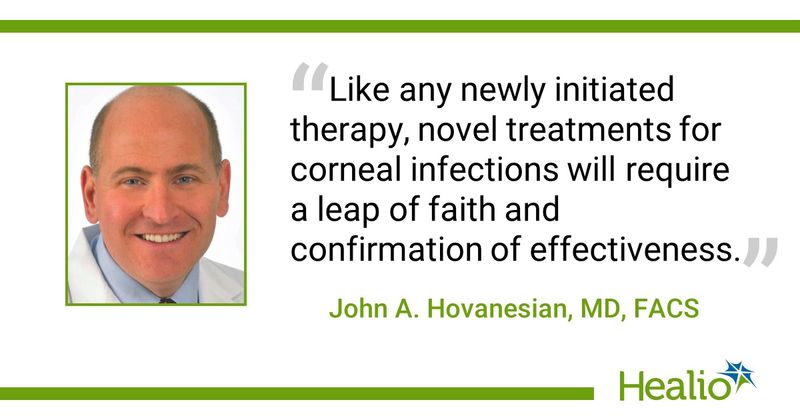BLOG: Two disruptors for corneal ulcers
In the cover story of this issue of Healio/Ocular Surgery News, we explore the challenges of treating ocular surface infections like contact lens-related corneal ulcers.
The approach we use today is much the same as during my cornea fellowship more than 20 years ago. We examine, culture, treat empirically with topical antibiotics, then follow the results and pivot according to the evolving clinical picture. However, in suspected bacterial keratitis, the most common cause of contact lens-related ulcers, we have few readily available solutions that are effective. Besivance (besifloxacin 0.6%, Bausch + Lomb) is the most concentrated topical fluoroquinolone antibiotic available, but it has very limited availability. Increasing regulation and enforcement have caused many local compounding pharmacies to close, requiring patients to wait for fortified antibiotics to be shipped.

The ideal treatment for bacterial keratitis need not be a new drug. What we want is high-potency topical exposure of broad-spectrum antibiotic delivered as soon after diagnosis as possible. If we can circumvent compliance problems, so much the better. Two new products involving compounded medication now offer that potential.
The first is Fortisite (tobramycin 1.5%, vancomycin 5%, ImprimisRx). This product can be ordered by the patient for overnight shipping or, crucially, be provided to the patient directly in the doctor’s office. Because Fortisite has a 180-day shelf life, every doctor can now stock this drug in every office and put it on the eye the moment the culture (if needed) is collected. It’s hard to estimate how many lines of visual acuity will be saved for patients who didn’t have to wait for their fortified antibiotics to arrive. Personally, I’m grateful that Imprimis has made this product available, and I hope every eye care provider considers ordering a bottle to have on hand in the office. Like other fortified antibiotics, the cost of Fortisite will generally not be covered by pharmacy benefits, but its cost will be comparable to locally (and more slowly) sourced antibiotics.
Another potentially new solution is contact lenses that slowly release antibiotic. Several drug-eluting contact lens platforms exist in development. Johnson & Johnson released the first antihistamine-releasing contact lens in early 2022, but by press time, the company did not confirm whether an antibiotic-releasing version is on the way. MediPrint Ophthalmics and TherOptix are addressing glaucoma and retinal disease, respectively.
However, one antibiotic-releasing contact lens is commercially available now through SaveWay Compounding Pharmacy. Glint Pharma’s MoxiLens is a silicone hydrogel soft contact lens embedded with moxifloxacin. The lens also contains vitamin E, which serves as a nanoparticle barrier to drug diffusion, and it has a 1-year nonrefrigerated shelf life. Applied to the eye, this lens will continuously release moxifloxacin for 2 to 3 days in its current formulation and up to 7 days with an update coming soon. While this product is still very early and has not yet undergone FDA testing, it could be a perfect solution for noncompliant patients with infection. I can imagine a day where a corneal ulcer patient receives a contact lens as first-line therapy and no drops. Meanwhile, let’s watch this company closely.
The legendary cornea specialist Bart Mondino used to say, “You can do anything in cornea. Just follow the patient closely.” Like any newly initiated therapy, novel treatments for corneal infections will require a leap of faith and confirmation of effectiveness. Meanwhile, I’m very glad our future patients who will one day present with terrifying corneal infections have perhaps better hope than those who have received the technology of the past 20 years.
Follow @DrHovanesian on Twitter.
Collapse
